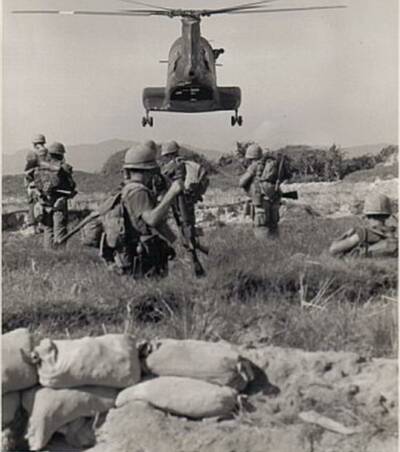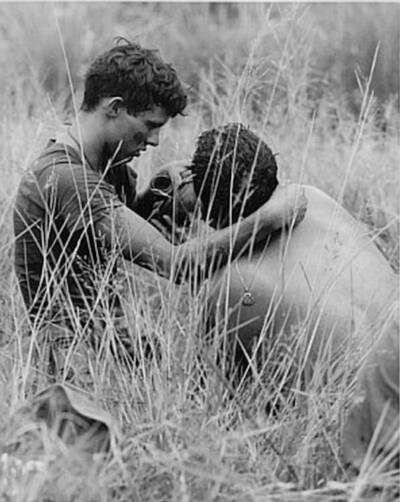This is the story that was done on me, by the Navy, while I was in Vietnam. It was a story being told about what a U. S. Navy Corpsman goes through while with the Marines.
Semper Fi,
Doc Osterman
NEWS RELEASE
COMMANDER/U.S. NAVAL FORCES VIETNAM
M7 PHAN DINHPHUNG. SAIGON
PHONE: TIGER 3341
NAVY RELEASE NO. 80-P-68
August 8, 1968
FOR IMMEDIATE RELEASE
NAVY COMBAT CORPSMEN TREAT MARINES III VIETNAM
"Corpsman! Corpsman!" The anguished cry of a wounded man is familiar to all Marines in I Corps, Republic of Vietnam. Also familiar is the Navy Corpsman who comes running to the aid of the injured man. Such a man is Navy Hospitalman Leslie G. Osterman, of 422 W. 10th St., Cheyenne, Wyo. The cry for aid brings him running with medical supplies, comfort and support.
As an enlisted Corpsman on patrol he needs almost as much skill as a general practitioner. But even more, he must be a friend, a father and sometimes a chaplain. By words and gentleness he does his best to make survival possible.
Not all of Osterman's work deals with wounds. He also has to cure simple things like sprained ankles, turned knees and heat exhaustion. Quick action and a thorough knowledge of first aid provide the remedy for these.
Osterman, like other Navy Corpsmen in Vietnam, is young in age, but old in experience. He must be a friend to each of his Marines, knowing their likes and dislikes. Some may call on him to help write a letter, others ask him to join them for a beer. Still others ask for a drink of his water. He'll give it cheerfully, though knowing he may need it himself later.
Long before coming to Vietnam, Osterman and his fellow corpsmen began preparing for their year with the Marines. They first entered Hospital Corpsman "A" School at either Balboa Naval Hospital in San Diego, or at Great Lakes Naval Hospital at Great Lakes, Illinois. There they spent six weeks mastering such subjects as Anatomy, First Aid, Minor Surgery, Patient Care, and Nuclear, Biological, and Chemical Warfare Defense.
From Hospital Corpsman School they went to four weeks of intensified training at either Camp Pendleton, California, or Camp Lejeune, North Carolina. In the short four weeks of advanced training, Osterman learned more First Aid, Casualty Evacuation Procedures and Special Warfare Medical Requirements.
Osterman's real job began when he finally was assigned to a Marine combat unit in Vietnam.
There he would use all that he had been taught and some things he had yet to learn. There he would learn that combat medicine is more than treating sprained ankles, broken legs or even mortal wounds. It can become a dilemma of alternatives — like who should be evacuated first and who should wait, or how far to risk his own life while saving someone else's — as a Corpsman, he must decide.
He must know what to do and then do it quickly. There is no time for long, drawn out thinking or a nervous hand. His rule of thumb, as with all people in the medical professions, is to treat the most serious first.
His greatest danger comes when he must treat wounds in the midst of a battle. The Marines respond by fighting their hardest, for they know that the Corpsman is trying to save one of their buddies, and that "Doc" must be protected to do his job.
For months he has walked with the Marines through mud and dust, heat and rain, sharing their lives, their joys and sorrows with all the vigor and resourcefulness his youth allows. But when they get hit, the young man grows old and comforts them — binding their wounds with all the skill and speed he has, or closing their eyes in death with compassion beyond his years.
Tomorrow and the next day and the rest of his year in Vietnam he'll do it all over again, as a Navy Corpsman with the Marines.

(1) His work completed, Osterman slumps wearily on the battle-scarred ground for a few moments rest.


(2) The last man in this Marine patrol is Navy Corpsman L. G. Otherman. He will stay back there, out of the way, until the patrol suffers casualties. Then he'll move in, treating the wounded and assisting them in any way possible.
(3) Snapshots from home are a welcome surprise at the end of a patrol, when Osterman and his buddies can relax, look over the snapshots and talk of home and families.

(4) An injection of Intravenous fluid is given by Hospitalman Leslie G. Osterman to a Marine injured by shrapnel in Vietnam.


(5) Even warm water tastes good to Osterman during a rare break. The lack of water can bring on heat exhaustion, which put a man out of action as surely as a broken ankle or enemy fire.

(6) The healing hands of Corpsman Osterman wrap the wound of a Marine injured by an exploding booby trap.
(7) A Marine receiving medical attention from Hospitalman Leslie G Osterman, a Corpsman with 3rd Marine Division up north in Vietnam's I Corps.

(8) Staring off into space, 20 year old Corpsman Osterman thinks of his wife and family, far away, and the men nearby who have died or clung to life in his hands.
(9) A cup of coffe is as refreshing to Hospitalman Leslie G. Osterman as to any other Navyman, even when a regular cup is not available, during a patrol with the Marines in Vietnam.
(10) During a break in the march, in Vietnam, Hospitalman Leslie G. Osterman and his company's Kit Carson scout exchange a few jokes. Kit Carson scouts are former Viet Cong who have rallied to the Vietnamese Government.
(11) A Medivac Helicopter lifts off and heads for the hospital after picking up one of Osterman's patients. The efficiency of the Corpsmen and the speed of evacuation have save many lives.



(13) His work complete, Hospitalman Leslie G. Osterman slumps wearily as on the battle-scarred ground for a few moments rest. He is a Corpsman on patrol with the Marines in Vietnam.
(12) Corpsman Osterman shares his water with a Marine with heat exhaustion while on patrol in the I Corps area of South Vietnam. Although exhaused himself, he completely forgets his own condition when his buddy needs his help.


